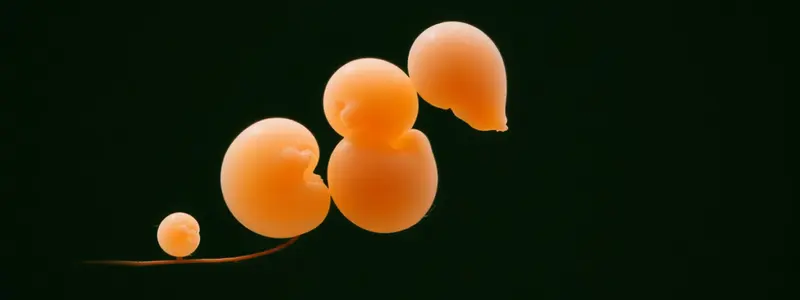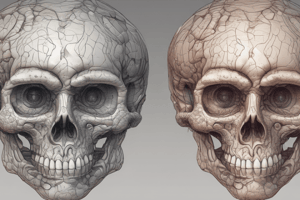Podcast
Questions and Answers
Which of the following organisms is the most likely to have the simplest cleavage pattern?
Which of the following organisms is the most likely to have the simplest cleavage pattern?
The amount of yolk does not influence the pattern of cleavage.
The amount of yolk does not influence the pattern of cleavage.
False (B)
What is the process of gut formation called?
What is the process of gut formation called?
Gastrulation
The process of giving birth through live offspring is called ______.
The process of giving birth through live offspring is called ______.
Signup and view all the answers
Match the following terms with their corresponding descriptions:
Match the following terms with their corresponding descriptions:
Signup and view all the answers
During cleavage, the first cleavage furrows appear at the ______ and progress toward the ______.
During cleavage, the first cleavage furrows appear at the ______ and progress toward the ______.
Signup and view all the answers
Which of the following is NOT a stage in embryonic development?
Which of the following is NOT a stage in embryonic development?
Signup and view all the answers
The term 'senescence' refers to the process of aging and loss of reproductive ability.
The term 'senescence' refers to the process of aging and loss of reproductive ability.
Signup and view all the answers
What are the three germ layers that form during early embryonic development?
What are the three germ layers that form during early embryonic development?
Signup and view all the answers
What is the function of vitellogenin?
What is the function of vitellogenin?
Signup and view all the answers
What is the term for the type of cleavage that occurs in eggs with a large amount of yolk?
What is the term for the type of cleavage that occurs in eggs with a large amount of yolk?
Signup and view all the answers
Homology in embryonic development provides evidence for evolutionary relationships between species.
Homology in embryonic development provides evidence for evolutionary relationships between species.
Signup and view all the answers
Study Notes
Life History Overview
- Life history is the process from embryo to death, encompassing stages from embryo to maturation to senescence.
- Stages include:
- Embryony: Early development stages.
- Maturation: Development from birth to sexual maturity, encompassing growth and learned skills.
- Senescence: Aging, loss of vigor, and reproductive ability.
- Ontogeny: Embryonic development from fertilization to birth/hatching.
- Metamorphosis: Abrupt changes in form during development; a stage.
Stages of Embryonic Development
- Zygote: Cleavage begins.
- Morula: Early stage of embryonic development.
- Blastula: Cleavage ends, formation of a hollow ball of cells.
- Gastrula: Gastrulation occurs - forming gut.
- Neurula: Neurulation - nerve formation.
Egg Structure and Cell Components
- Egg is a cell.
- Outer membrane - Cell membrane.
- Inner membrane - Cell membrane.
- Albumen - Cytoplasm.
- Vitelline membrane – Cytoplasm.
- Yolk – Nutrients.
- Blastoderm – Nucleus.
- Chalaza - Supports egg structures.
- Air cell – Supports egg structures.
Yolk Formation and Transport
- Vitellogenin is the precursor to yolk and it starts in the liver.
- Transported from liver to blood.
- Carried to ovary, accumulates in ovum.
- Transformed to yolk platelets for nutrient storage.
- Amount of yolk stored differs by species.
Processes in Embryonic Development
-
Cleavage: Repeated mitotic cell divisions after fertilization.
-
Holoblastic cleavage: Complete division of the zygote.
-
Meroblastic cleavage: Incomplete division of the zygote; localized to a disc.
-
Discoidal cleavage: Incomplete division that occurs at a disc; meroblastic type.
-
Animal pole: Active cytoplasm, nucleus.
-
Vegetal pole: Less active cytoplasm, yolk.
Terms Relating to Cleavage Patterns
- Microlecithal: Little yolk.
- Mesolecithal: Moderate yolk.
- Macrolecithal: Large amount of yolk.
- Isolecithal: Yolk uniform throughout.
- Telolecithal: Yolk concentrated to one end.
Different Types of Reproduction
- Ovipary: Eggs laid outside the body.
- Ovoviviparity: Eggs kept inside the body until hatching.
- Viviparity: Development inside the mother's body, nourishment is provided.
Reproduction Processes
- Parturition: Act of giving birth.
- Oviposition: Act of laying eggs.
- Partition: Includes both parturation and oviposition.
Germ Layers and Development
-
Cells of embryo form three germ layers during development:
- Ectoderm
- Mesoderm
- Endoderm
-
Germ layers give rise to specific body organs
-
Steps of embryonic development are homologous.
-
Homology in species indicates evolutionary relationships.
Embryology Terminology
- Corona radiata: Outer layer of follicle cells surrounding egg.
- Chromosomes: Genetic material of egg or sperm.
- Nucleus: Control center of the egg.
- Cortical granules: Structures involved in fertilization.
- Zona pellucida: Vitelline membrane in mammals; fertilization membrane.
Studying That Suits You
Use AI to generate personalized quizzes and flashcards to suit your learning preferences.
Related Documents
Description
This quiz covers the fundamental stages of life history, from embryonic development through senescence. It touches on key processes such as embryony, maturation, and metamorphosis, as well as detailed descriptions of the embryonic stages like zygote, morula, and gastrula. Enhance your understanding of developmental biology with this comprehensive quiz.




